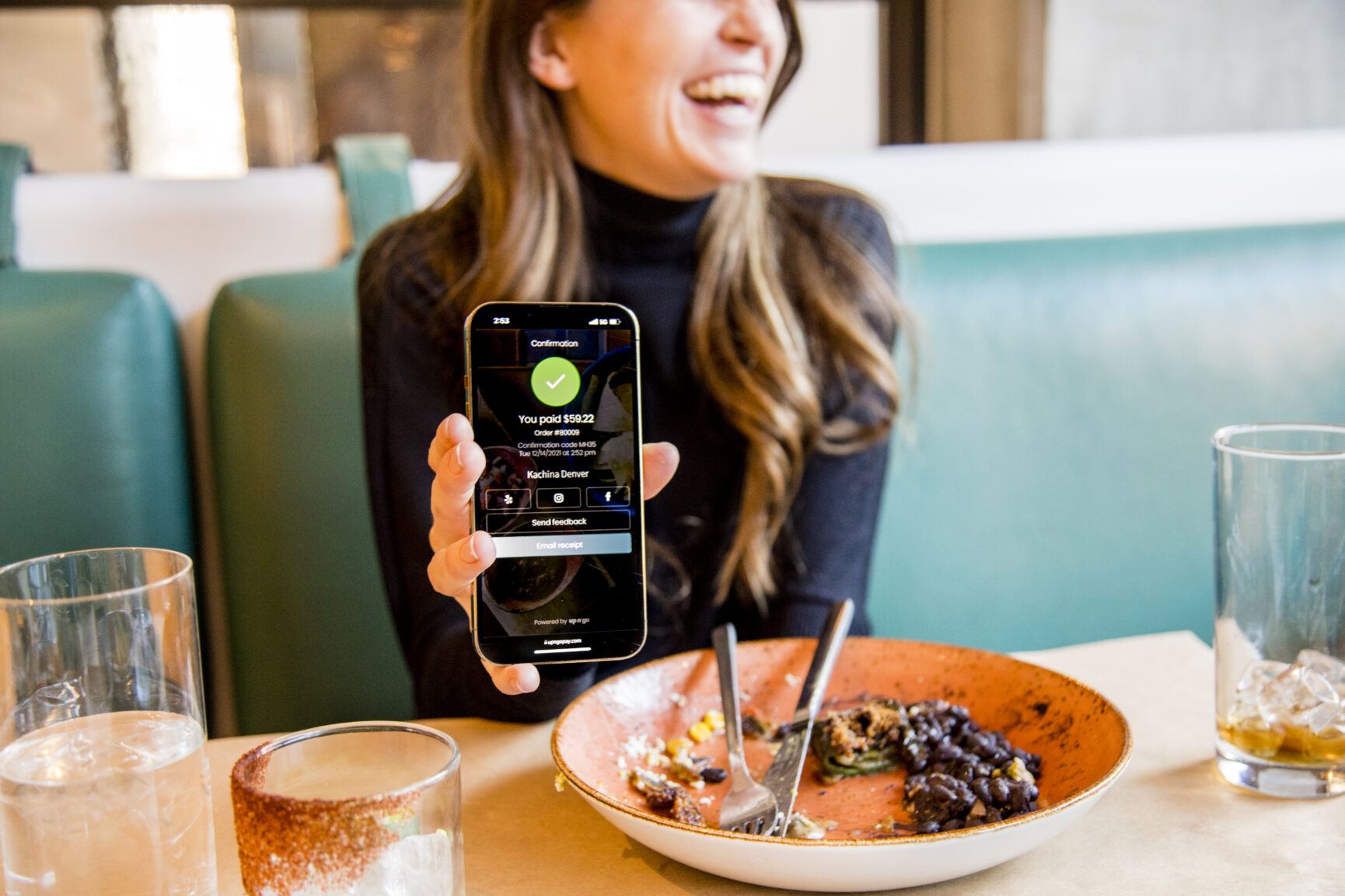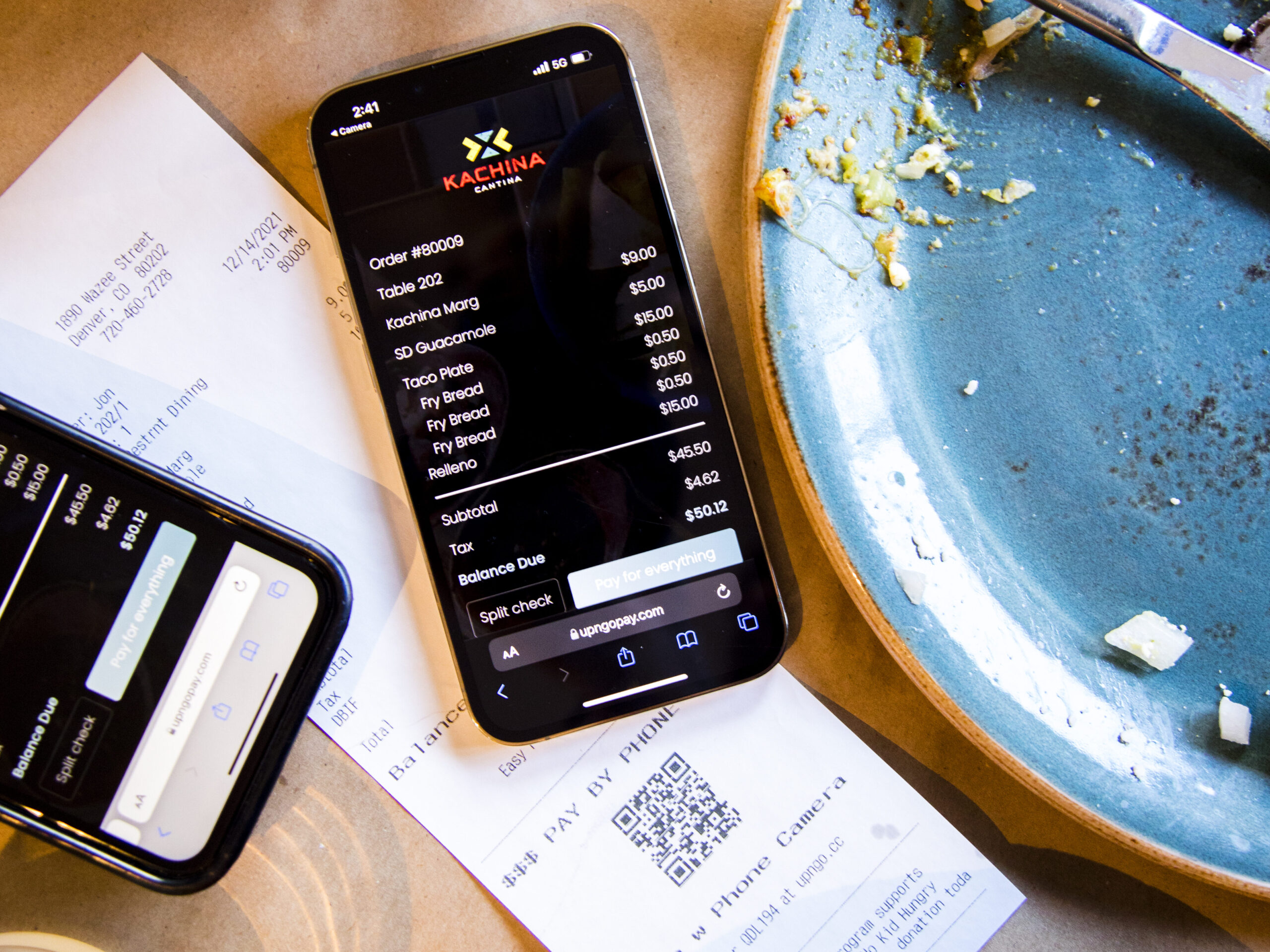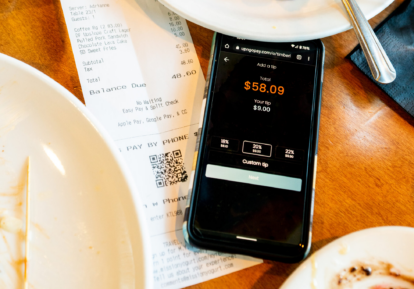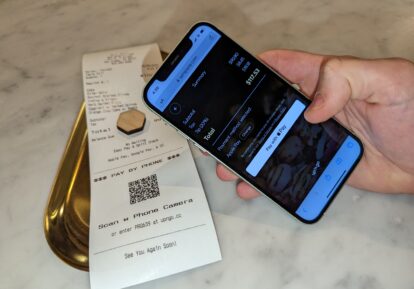
Contactless Payment Options for Restaurants
There are three types of contactless payment solutions available to restaurants, broadly speaking. These are QR codes, text-based payments, and hardware-based contactless payment terminals. Contactless payment solutions are now widely expected by restaurant guests for convenience and security, so it’s advantageous to offer them in your restaurant.
Contactless payment solutions lets you attract guests by accepting Apple Pay and other digital wallets, turning tables faster by enabling guests to pay sooner, and increasing guest satisfaction because payment is an emotional part of every dining experience and you want to get it right.
Let’s take a look at the the three types of contactless payment options available to restaurants:
Restaurant Contactless Payment Option #1: QR Codes
QR code payments can be quick, easy, and inexpensive to deploy in your restaurants. Deploying QR codes doesn’t require new hardware, which saves money and time. QR code payment solutions can be fully integrated with your existing restaurant point of sale system, like Aloha, Micros Simphony, or Toast.
QR codes let guests scan a QR code at the table and use their phone as the payment device. Guests love using their own phones because they don’t have to touch often-dirty devices with unfamiliar interfaces.
When a guest pays at the table with their phone, they get a lot of control over the payment and staff saves a lot of time. Guests can split the check fairly by item, easily pay with a digital wallet like Apple Pay, and don’t have to be awkwardly watched over by a server while deciding on a tip.
Servers don’t have to stand around at a table or POS terminal to collect payment. They can use their time more profitably by selling more food at drink at another table, or by making sure other parties get their food before getting hangry.
When using QR codes, guests are loading your brand onto their phone! This makes it easier to get guests to sign up for your restaurant’s loyalty program, follow your socials, answer guest satisfaction surveys, and provide their email address so you can send them promotions. You can even make it easy for guests to reserve their next visit with a simple reservation link on your payment confirmation screen.

There are two ways to deploy QR code payments at the table:
QR Code Pay at the Table Option #1: Print QR codes on checks
With the right payment technology partner, like Up ‘n go, your POS can be configured to automatically print a unique QR code on each check. When your servers drop checks at the table, they’ll automatically have QR codes printed on them that your guests can scan to view and pay their bill.
This is the quickest and easiest model to deploy because your existing receipt printers will automatically add QR codes to checks when they’re printed. There’s no new hardware to buy or deploy. Even though the server has to bring the check to the table before a guest can scan and pay, it saves a lot of time. The time-wasting steps that normally come after dropping a check go away.
When QR codes printed on checks, guests will pay the correct checks in full. Since the server delivers the QR code, you know that payments won’t be attempted prematurely, which could leave items unpaid. QR codes on checks will only be made available at the end of the meal, so the check will include everything ordered. This ensures payment for everything ordered.
Pros: Inexpensive, Quick to deploy, Saves staff time, Preferred method of guests, Easier for guests to split by item, Can turn off voucher printing and save receipt paper
Cons: Must drop check first
QR Code Pay at the Table Option #2: Affix QR codes to tables
An alternative to printing QR codes on checks is putting QR codes on tables. You can put table stickers or some doohickey with a QR code on every table. This might seem like the better option because guests can pay sooner, but there can be a lot of drawbacks to putting QR codes on tables.
If you put QR code stickers on tables, people will pick at them and they’ll get dirty and eventually deteriorate. If you put QR codes on objects on tables, QR codes will invariably end up on the wrong tables. The wrong checks will get paid, or people might not even find their checks if they scan a QR code for the wrong table with no check on it. Also, QR codes on restaurant tables can dramatically degrade the look and feel inside your restaurant. Is your restaurant going to look better or worse with QR codes everywhere?
Finally, there’s a huge logistical effort required to put QR codes on tables. Every QR code on a table must be unique and registered to the specific table where it was placed. You may have to pay for custom stickers or QR code objects to place on your tables, so there could be an extra expense. You’ll need to plan for replacement stickers or objects because invariably they’ll need to be replaced. If you don’t want service to be impacted, you’ll have to have those replacements on-hand for immediate use at any time.
Pros: Guests can pay anytime
Cons: Guests may pay too soon leaving items unpaid, Restaurant look-and-feel impacted by QR codes, Logistics required to deploy and maintain QRs on tables, QR codes may end-up on wrong tables, QR code stickers or objects may deteriorate or get lost, Ongoing requirement to replace compromised stickers or objects
Restaurant Contactless Payment Option #2: Text the check
Texting is another lightweight way to offer contactless payments. It lets you accept payments from both inside out outside of your restaurant and it addresses a variety of use cases.
Text the Check Use Case #1: Pay at the table
Texting guests while they’re at the table is a promising new contactless pay at the table option for restaurants. In this model, your server takes a handheld ordering device to the table. The server can ask the guests if they want to pay by text, ask for their mobile number, and then enter it into their handheld ordering device. The guests will instantly get texted a payment link. If the guests want to split the check, the person who received the text can in turn text the payment link to others at the table.
Pros: Make more use of handheld device investments, Server can leave table sooner, Guests get more control of splitting, COLLECT SURVEY DATA, EMAILS, GET SOCIAL FOLLOWERS, PROMT GUESTS TO RESERVE NEXT VISIT
Cons: May be hard to hear phone numbers at the table
Text the Check Use Case #2: Call-in orders
Call-in orders are the most popular use case we’ve seen for text payments at restaurants. No matter how many options you have for online ordering, some customers will call-in orders instead.
With text the check, you can ask the caller for their mobile number over the phone and enter it directly into your restaurant POS. With a service like Up ‘n go, we then text a link to pay that check to the phone number entered into your POS. The payment will magically appear in your POS once it’s made.
Accepting payment with Up ‘n go’s text the check is fully PCI compliant, unlike when staff verbally take credit card numbers over the phone. To maintain credit card security and protect your business from financial liability, you don’t want to accept credit card numbers over the phone!
Texting the check lets restaurant staff get off the phone quicker, and it means less disruption for servers when guests arrive to pick up orders. The to-go orders will be paid before the guests arrive for pick up. Guests love the convenience of paying in advance on their phones.
Pros: Avoids the PCI compliance violation of taking credit card numbers over the phone, Saves staff time
Cons: None 🙂
Text the Check Use Case #3: Third-party payments
Have you ever had someone call in to pay for a bottle of champagne for a couple celebrating their anniversary in your restaurant? Third-party payments like these are more popular than one might think.
In this model, someone outside of your restaurant wants to pay for guests currently dining in your restaurant. Or they could pay for guests before they dine in your restaurant, a restaurant prepayment.
Texting the check is the perfect solution for this problem. Ring up the check, add the caller’s mobile number, and with a service like Up ‘n go, the recipient will receive a secure payment link by text. Texting the check lets you conveniently and securely accept in-store payments from off-premises.
Pros: Avoids the PCI compliance violation of taking credit card numbers over the phone, lets your guests be delighted when someone wants to help pay for their dining experience
Cons: None 🙂
Restaurant Contactless Payment Option #3: Payment Terminals
Payment terminals are the most traditional way to collect payment in a restaurant. From a contactless payment perspective, these include payment devices that have a built-in tap to pay, or NFC capability. Depending on the payment terminal you buy, these are often integrated with chip readers.
There are three general types of contactless payment terminals you can add to your restaurant: credit card payment terminals connected to each POS terminal, payment devices installed at each table, or handheld devices that can be carried to tables by staff. Let’s take a closer look at each:
Payment Terminal Option #1: Contactless payment devices at each POS terminal
This is probably the most straight-forward option since every restaurant POS terminal needs a way to accept credit cards. As restaurants transition from credit card swipers to chip readers, you’ll find that many new credit card chip reader terminals also accept contactless payment using NFC.
This option is great for quick service and fast casual restaurants who accept payment at the counter, but it’s not a useful contactless payment solution for casual dining, fine dining, and other table service restaurants. Servers aren’t going to walk a guest from their table to a stationary POS terminal to tap their phone for an Apple Pay payment.
This is so impractical as to not be a true contactless payment solution for a table service restaurant.
Pros: Many payment terminals already have contactless technology
Cons: Not practical for casual dining, fine dining, and other table service restaurants
Payment Terminal Option #2: Handheld contactless payment devices
Handheld payment devices become interesting when they’re available as a feature of handheld ordering devices for restaurants. With some point of sale systems like Toast, handheld ordering devices are a well integrated part of the POS and thus fairly popular. Putting in orders at the table gets them into the kitchen quicker, which speeds up food delivery. If your staff are using ordering devices, they can use them to accept contactless payments at the table.
While tapping NFC credit cards may be popular with these devices, they don’t seem to drive much use of Apple Pay, Google Pay and other digital wallets. When a server has a device at your table, you’re much more likely to hand them your credit card to swipe or dip, which isn’t a contactless payment. Tons of restaurant guests want to use Apple Pay in restaurants, but are not likely to pay with Apple Pay if it means tapping a phone to a payment device a server is holding over a table.
When a server takes payment at the table with a device, you get that awkward moment (over and over again) where a server usually turns their head away from the guest while the guest is forced to enter a tip while the server waits right next to them to get tipped. I’m not sure anyone enjoys that moment. Also, with payment devices at the table, the server is usually still present and because the payment is rushed, there really isn’t a good opportunity for the guests to pay by item, which is a more fair way to pay.
To deploy handheld devices in restaurants, you’ll want to consider the cost of the devices, which can be $600 – $1000 or more and you usually need many devices. Since these devices use Wi-Fi and need coverage throughout your dining room (they have to work at every table), some restaurants will need to upgrade their Wi-Fi infrastructure, including the installation of new routers. Handheld devices must be kept charged, so you’ll need room for charging stations. Handheld devices need to be kept clean and sanitary. When they break, they’ll need to be replaced. You may want to purchase more handheld devices than you need in order to have spare devices on-hand.
If you take the approach of leaving these devices on the table for guests to use so the server can walk away, you’ll have to make sure guests actually complete their payment and that they don’t take the expensive devices out of your restaurant when they leave.
Pros: If used for ordering, orders get to kitchen quicker
Cons: Requires staff time at table, Devices are expensive, Batteries die, Devices get dirty, Replace broken devices, Wi-Fi investments often needed, Devices could get stolen
Payment Terminal Option #3: Payment terminals installed at each table
Installing contactless payment terminals at each table requires the largest investment of all contactless payment solutions. Rather than buying a device for each terminal, you need to buy a device for each table. You’ll need to make sure power is run to each table, and you’ll need to make sure Internet connectivity is available at each table. You’ll need to wipe down the devices after each guest and you’ll have to inspect each device daily, since devices left at tables are more likely to get abused by guests.
If you’re installing a device at each table, there’s a good chance you’d use it for ordering also. If you’re operating a fine dining restaurant, or even a casual dining restaurant, you may alienate some guests if you make them enter their own orders. When guests go to restaurants, they’re looking for service, not just food. They’re looking for a human touch. We’ve surveyed guests and seen that the majority want to order with a server when they’re in a restaurant. Guests also order more food and drink when ordering from servers than from devices. Servers are better at upselling, despite claims to the contrary.
With devices at tables, you’ll be substantially changing the nature of your restaurant. The look and feel of a restaurant with a computer terminal on each table is much different than the look and feel of a restaurant without technology visible on tables. It’s quite likely your restaurant will move downmarket and existing guests will transition their business to restaurants that offer more service. Dining out is not just about food and a table to eat it on. Dining out is about receiving service and a human touch. Payment and ordering devices at each table fundamentally change the offering within your four walls.
Some tabletop devices include the ability to sell games to children and toute game sales as a money maker. Are you a restaurant or an arcade? Selling games at a restaurant table is a different business line that represents a departure from serving food. With the overwhelming availability of iPhones, iPads, and other tablets, most children have their own gaming devices wherever they go, including at restaurant tables.
Pros: None 🙂
Cons: Alienate guests looking for more service, Upfront expense to install devices and run power to each table, Expense to ensure Wi-Fi connectivity at each table, Time required to keep devices clean and constantly ensure each device is functioning, Expense and time needed to replace broken devices
Conclusion
You have several options when it comes to adding a contactless payment to your restaurant. You can even include more than one! For instance, you can arm your staff with handheld ordering devices and be willing to accept credit cards with them, but also have the ability to text the guest the check right at the table using the ordering device. You could also use text-the-check for call in orders and third-party payments. Text the check can solve many use cases and supplement other contactless solutions at the same time, like QR code payments or handheld devices.
Some options are less expensive and easier and quicker to deploy, like QR code payments or texting, while some require substantially more planning and investment, like deploying order and pay devices at your restaurant tables. These hardware deployments are not permanent, as all hardware becomes outdated and will eventually need replacement. So when you undertake a large hardware deployment in your restaurant, you’re also committing to do it again in five years, and then again five years after that, and so on. In contrast, when you use a solution like QR code payments or text-to-pay, your guests are bringing in the hardware and they will pay for their own hardware replacement.
Remember that each of these choices also impacts the nature of your business. Putting QR codes on tables will impact your restaurant’s design. Putting payment terminals on tables will further impact your restaurant’s design and change the nature and level or service offered in your restaurant.

